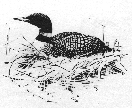Mercury Alert!
Background
Mercury
is a lovely and unique mineral. It is the only metal that is a liquid
at normal room temperatures. Mercury flows so beautifully that it is also
called quicksilver. Ancient people in China, Egypt, Greece, India,
and Rome knew about
mercury, which was named for the swift messenger in Roman mythology. (The
quick-moving planet was also named for the same Roman character.)
Mercury has many wonderful uses. It expands and shrinks evenly as the temperature
rises and falls, making it perfect for filling thermometers. Mercury mixed
with zinc and cadmium makes batteries last longer. It used to be used a lot
in house paints to protect them from the elements, make them stronger, and
to make wonderful red tints. Mercury vapor gives off light when electricity
passes through it, so mercury is used in fluorescent lights. And doctors used
mercury as a very effective antibiotic on wounds.
 |
But
despite all mercury's useful properties, it is extremely poisonous
to humans and animals--especially loons. Eating a very tiny amount
of mercury won't cause
serious harm for a critter or person, but the problem is that mercury is
a cumulative poison. This means the body has a very hard time getting
rid of
it. Little by little, mercury accumulates in someone exposed to it over
time. Eventually the buildup reaches dangerous levels.
Mercury, like other metals, occurs naturally in rocks. When a rock containing
mercury dissolves or breaks up, mercury is released into water, air, or soil.
Bacteria take in tiny particles of mercury, combining it with methane to produce
methyl mercury. This is the most toxic form of mercury, and it can damage brain
cells.
Loon Feathers: A Clue to the Past
Mercury eaten by loons is carried by their blood to many body tissues,
including growing feathers. When the feathers stop growing, they stop taking
in mercury. By analyzing loon feathers, scientists can determine how much
mercury a loon was exposed to during the time it molted into its feathers.
The mercury stays in the feathers as long as the feathers exist. This means
that scientists can analyze feathers from loons in museums to find out
how much mercury loons in different places were exposed to over a hundred
years ago!
Mercury Studies and the Food Chain Connection
 |
All
natural systems have tiny amounts of mercury. Environmental scientists
measure
the amount of some chemicals in lakes in "parts per billion" (ppb).
One lake with moderate levels is Little Rock Lake, in northern Wisconsin. In
Little Rock Lake, mercury levels are about 0.0001 ppb. This means 0.0001 grams
of mercury for every billion grams of water.
EPA
scientists studying Little Rock Lake have measured the amount of mercury
in various living things in the lake. This is
what they found:
|
Material |
Amount of Mercury |
|
Water |
0.0001 ppb |
|
Phytoplankton (algae) |
15 ppb |
|
Zooplankton |
54 ppb |
|
Fish |
200 ppb |
|
Loons |
1250 ppb |
|
Insects |
not tested |
The amount of mercury in algae is 150,000 times the amount in the water! This is because the tiny plants "bioaccumulate" the mercury. At each level of the food pyramid, the animals have more mercury buildup than the level beneath.
Why do mercury levels jump so much at each level of the food chain?
 |
In the Little Rock Lake study and the Ontario Study, what factors might have contributed to the differences in data?
Extensions:
Hazardous Waste: How Can We Help?
- Keep hazardous waste in its place. Find your local waste disposal
facility in your phone book. As a class project, find out where
your garbage goes, and how people in your area should dispose
of old thermometers and other products that may contain mercury.
You might even write a letter to the editor of your local newspaper
telling people how they should dispose of these items and why
it's important. Remember: When garbage is burned, some of the
material ends up in the air, often as pollution. When garbage
is buried, sometimes rain washes poisons from it through the
soil into the groundwater. Not long ago, the mercury from button
batteries, high-efficiency light bulbs, fluorescent lights, paints,
and thermometers ended up in our water or air. Now batteries
are manufactured with different chemicals, and many people are
choosing non-mercury thermometers. But it's still critical to
make sure old thermometers and fluorescent bulbs are disposed
of properly. Most localities now have a way of recycling these
dangerous items if they are brought to a hazardous waste disposal
site. Where is YOURS?
- Going Fishing? Get the Lead Out! Buy lead-free sinkers and use them when fishing. A company called Bullet Weights will send information and steel sinkers to the first 500 students who write. Read more about how lead affects loons, and find out how to get steel sinkers for fishing at:
Going Fishing? Get the Lead Out!
Largemouth Bass
Remember: Lead and mercury aren't good for ANY living things. A world
safer for loons is a world safer for us all!



